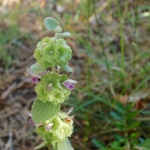Ballota acetabulosa
Greek horehound Λυχναράκι, φουφούλες

Labiatae - mint family Dicot.
Ballota acetabulosa
Greek horehound Λυχναράκι, φουφούλες

Labiatae - mint family Dicot.
Seen throughout most of the year as erect, brittle stems covered in pale dry leaves and bracts. Ballota acetabulosa first appears in early summer as shoots with light green, thick, crinkly leaves. The flowers, which appear soon after the leaves, are inconspicuous white tubules striped with purple, each is surrounded by a pale green bract and arranged in crowded spikes, The flowers quickly fall but the bracts continue to grow and form the tiny papery cones which are characteristic of the plant.
Ballota acetabulosa is endemic to the Aegean, growing naturally nowhere else in the world. They are well adapted to hot dry conditions and thrive on stony ground. They are important plants of phrygana but also found on wasteland, neglected fields and roadside.
♉↕1.5-2cm, ↨ 15-40cm. ⟷20-60 JAN FEB MAR APR MAY JUN JUL AUG SEP OCT NOV DEC



